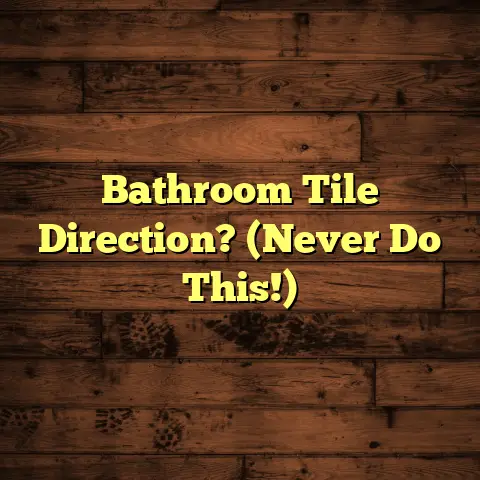Pour Concrete in a Pole Barn (2 Critical Steps!)
A Wise Investment Through Two Critical Steps
As a flooring contractor, I’ve seen firsthand the amazing transformations a good concrete floor can bring to a pole barn.Think of it: no more muddy messes, easy cleanup, and a solid foundation for whatever you want to do.
Pouring concrete in a pole barn is a smart move. It boosts functionality, adds durability and increases the overall value.
I’m going to walk you through the two critical steps that’ll make your pole barn project a roaring success. Let’s get started!
Understanding the Benefits of a
Concrete Floor in a Pole Barn
Why concrete, you ask? Well, the advantages are pretty compelling. I’ve seen concrete floors in pole barns last for decades.
-
Durability is Key: Concrete is tough. I’ve seen it withstand heavy equipment, vehicles, and just about anything you can throw at it.
-
Low Maintenance is a Winner: Forget constant repairs. A sealed concrete floor is easy to clean and maintain.
Sweep it, mop it, and you’re good to go. I’ve had clients tell me it’s saved them tons of time.
-
Pest Resistance is a Relief: Rodents and insects can’t burrow through concrete. This is a big win for storage, workshops, or agricultural uses.
-
Heavy-Duty Support: Need to park a tractor? Store heavy materials? A concrete floor can handle it. I’ve seen floors support incredible weight without cracking or buckling.
-
Property Value Boost: A concrete floor adds value to your property. It makes the pole barn more attractive to potential buyers or renters. It’s an investment that pays off in the long run.
I remember one client who increased their rental income significantly just by adding a concrete floor.
The numbers don’t lie. According to the National Association of REALTORS®, improvements like these can increase property value by as much as 5%.
That’s a solid return on investment! So, are you ready to take the plunge?
Preparing for the Pour
Okay, now for the nitty-gritty. Proper preparation is the secret sauce to a successful concrete pour. Trust me on this one.
Step 1: Planning and Design
Planning is the foundation of any good project. I always tell my clients, “Measure twice, cut once.”
- Layout Considerations: Think about how you’ll use the pole barn. Where will you park vehicles? Where will you store equipment?
I suggest sketching out a floor plan to visualize the space.
- Thickness Matters: The thickness of the concrete depends on the intended use. For light storage, 4 inches might suffice. For heavy equipment, go for 6 inches or more.
I’ve seen people try to skimp on thickness, and it always leads to problems down the road.
- Building Codes are Crucial: Check your local building codes and regulations. They’ll dictate requirements for thickness, reinforcement, and drainage.
I can’t stress this enough. Ignoring building codes can lead to fines and delays. Nobody wants that.
Step 2: Gathering Materials and Tools
Having the right materials and tools on hand will save you time and frustration. I always make a checklist before starting any project.
- Materials Checklist:
- Concrete mix (or ready-mix)
- Rebar (for reinforcement)
- Gravel (for base)
- Forms (wood or metal)
- Plastic sheeting (vapor barrier)
- Expansion joints
-
Sealer
-
Tool Time:
- Concrete mixer (if mixing on-site)
- Wheelbarrow
- Shovels
- Rakes
- Screed
- Trowels
- Floats
- Edger
- Groover
- Safety glasses
- Gloves
-
Boots
-
Quality Counts: Don’t skimp on materials. High-quality concrete and rebar will ensure a durable, long-lasting floor. I’ve learned this the hard way.
I once used a cheaper concrete mix and the floor cracked within a year. Lesson learned!
The Pouring Process
Alright, let’s get to the fun part: pouring the concrete! This is where all your planning and preparation come together.
Step 3: Site Preparation
Preparing the site is crucial for a level, stable concrete floor. I can’t emphasize this enough.
-
Clearing the Area: Remove any debris, vegetation, or topsoil from the area. You want a clean, solid base.
-
Leveling the Ground: Use a shovel and rake to level the ground. A laser level can help you achieve a perfectly flat surface.
-
Compacting the Soil: Rent a plate compactor to compact the soil. This will prevent settling and cracking later on. I always recommend compacting in layers for best results.
-
Drainage is Key: Ensure proper drainage to prevent water accumulation. Create a slight slope away from the building if necessary.
-
Forming the Perimeter: Install forms to hold the concrete in place. Use wood or metal forms, making sure they’re level and secure.
-
Reinforcing with Rebar: Install rebar to reinforce the concrete. Use a grid pattern, spacing the rebar according to your design.
I typically use rebar spaced 12 inches apart for a standard pole barn floor.
Step 4: Mixing and Pouring the Concrete
Now, for the main event! Mixing and pouring concrete requires some finesse.
-
Mixing Options: You have two options: ready-mix concrete or mixing on-site. Ready-mix is more convenient, but mixing on-site can save you money.
-
Ready-Mix Advantage: With ready-mix, the concrete is mixed at a plant and delivered to your site. This ensures a consistent mix and saves you time.
-
On-Site Mixing: If mixing on-site, use a concrete mixer and follow the manufacturer’s instructions. Add water gradually until you achieve the desired consistency.
-
Timing is Everything: Pour the concrete on a day with moderate temperatures. Avoid pouring in extreme heat or cold.
-
Pouring Technique: Pour the concrete evenly into the forms. Use a shovel and rake to spread it out.
-
Screeding the Surface: Use a screed to level the concrete. A screed is a long, straight board that you drag across the surface to remove excess concrete.
Step 5: Finishing the Surface
Finishing the surface is where you can add texture, color, and control joints.
-
Troweling: Use a trowel to smooth the surface. Start with a float to bring the cream to the top, then use a steel trowel for a smooth finish.
-
Broom Finish: For a non-slip surface, use a broom to create a textured finish. This is ideal for areas where you’ll be walking or driving.
-
Adding Texture and Color: You can add texture and color to the concrete by using stamps or stains. This can enhance the appearance of your pole barn floor.
-
Control Joints: Cut control joints into the concrete to manage cracking. These joints create weak points where cracks are likely to occur.
I typically cut control joints every 10-12 feet.
- Curing Process: Curing is essential for a strong, durable concrete floor. Keep the concrete moist for at least 7 days by covering it with plastic sheeting or spraying it with water.
Post-Pour Maintenance and Care
Even after the pour, you need to take care of your new concrete floor. I always advise my clients on proper maintenance.
-
Cleaning: Clean the floor regularly to remove dirt and debris. Use a mild detergent and water.
-
Sealing: Seal the floor to protect it from stains and damage. Apply a concrete sealer every few years.
-
Addressing Issues: If you notice any cracks or surface wear, address them promptly. Small cracks can be repaired with concrete patch.
Conclusion
Pouring concrete in your pole barn is a wise investment that will enhance its functionality, durability, and value.
Remember the two critical steps: preparation and execution. Careful planning and attention to detail will lead to a successful outcome.
So, are you ready to take the plunge and transform your pole barn with a beautiful, durable concrete floor? I think you are! Go for it! You won’t regret it.





